The muzzleloader can be a freezer-saver; many states offer a special season after, or sometimes before, the regular rifle season, and there may even be an additional tag involved. I have had deer seasons where the centerfire rifle went unfired for the entire season, and the muzzleloader was relied on to put meat in the freezer.
Why A Muzzleloader
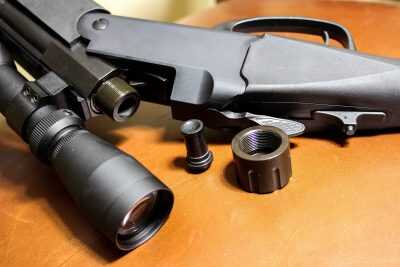
The T/C Adapt breech system is an innovative and highly useful improvement in muzzleloader technology.
The beautiful Pennsylvania and Kentucky rifles — with all the wonderful accouterments in brass — are a joy to shoot and even hunt with, but they are very expensive to make, and a bit finicky in less-than-perfect weather conditions. Modern muzzleloaders need to be reliable, and in the opinion of this author, the in-line muzzleloaders are the most reliable design to date. Thompson/Center, who did muzzleloaders before muzzleloaders were cool, again, has remained at the forefront of muzzleloader development, and they’ve continued that with the T/C Strike.
The T/C Strike
While this rifle doesn’t exactly resemble the flamed-maple, octagon barreled masterpieces of yesteryear, it is utterly reliable. And, I’d like to get this out of the way right now: it’s got a trigger guard that is, well, ugly to my eyes. It kinda looks like an aerodynamic egg or something out of Buck Rogers or The Jetsons. I tried it with hunting gloves on, and it makes sense, but I find it silly looking. Now that that’s over with, there’s a lot to be happy about with the Strike.

The T/C Strike’s receiver is free from clutter and allows a riflescope to be mounted good and low; helping with quick target acquisition.
SPECS
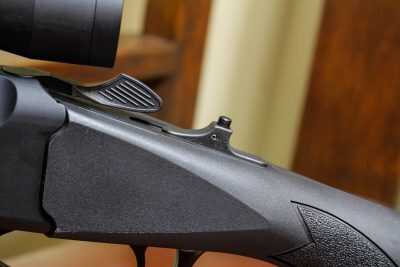
T/C’s Stealth Striker ambidextrous safety is more than that. It is a cocking device, leaving the rifle completely inert until the striker is pushed forward, putting the rifle into battery.
- Type: Muzzleloader
- Cartridge: .50
- Breech Plug: Breech Adapt System
- Capacity: 1 rd.
- OAL Length: 41 in.
- Barrel Length: 24 in.
- Length of Pull: 13.5 in.
- Weight: 7 lbs., 8 oz.
- Trigger: 2 lbs., 14 oz. (tested)
- Stock: Polymer
- Finish: Armornite
- Sights: Green fiber optic (front); adjustable red fiber optic (rear)
- MSRP: Starting at $499
- Manufacturer: Thompson/Center
My test model came equipped with a black polymer stock and the Armornite nitride finished barrel. It’s a break action affair, with a side lever to open the action, in the fashion of grandpa’s old shotgun, and cocks upon closing. A hefty hinge pin keeps things in one place. It even disassembles in the fashion of grandpa’s gun, with one ingenious addition: the forend screws to a block, which is affixed to the underside of the barrel with a screw that also acts as a sling stud. That block is also drilled to hold the ramrod, making for a neat package, which is easily disassembled in the field.
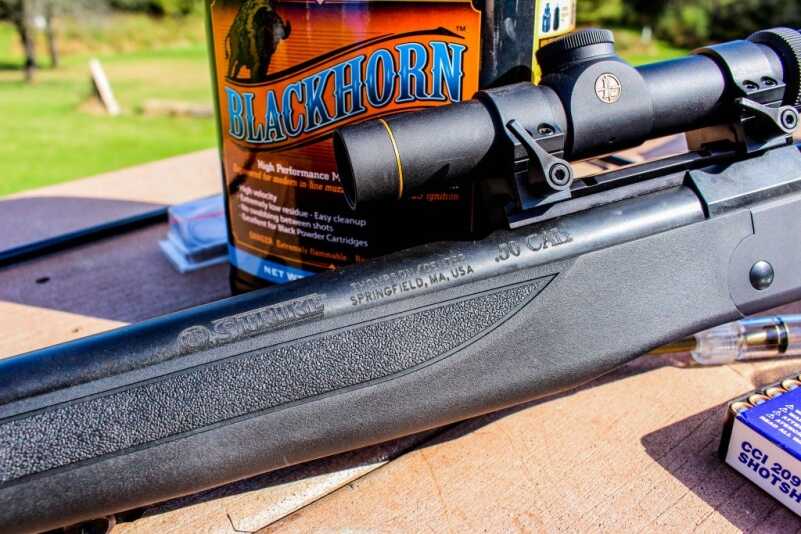
At the bench, the T/C Strike showed that advantages of all those new features. The breech cap came off easily for cleaning, and obtaining good cheek weld with the low-mounted scope made shooting a pleasure.
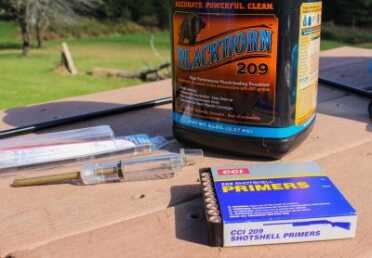
Blackhorn 209 is a great blackpowder substitute. It worked nicely in the T/C Strike. Though it comes in granulated form, which is a bit more difficult to load than pelletized powder, it would be easy to load with some speedloaders.
The Armornite finish is tough — even tougher than my acidic hands — and coats the 24-inch barrel inside and out, a very important feature for a muzzleloader. Anything that can help keep the bore free from corrosion, rust and pitting is a good thing. The breech and firing system are completely revolutionary and in a good way. Starting with the breech plug, T/C has fixed an old problem with inline muzzleloaders: that damnable breech plug. With threads located on the inside of the breech, the older designs quickly become corroded, rusted, buggered, jammed, and a source of new and inventive curses. I’ve seen inline muzzleloaders rendered inoperable, no matter what solvent we used to try to break the bastard loose. The T/C Strike uses a new style of breech plug in the Adapt Breech system, with an unthreaded primer adapter – with a rubber O-ring to seal things good and tight – held in place with a threaded cap that goes over the breech. This keeps the threads on the outside of the ignition site, and much cleaner. If kept properly lubricated, the cap is easily removed by hand. A wrench is provided — and should be carried — in case things do get sticky. Two primer adapters are provided with the rifle, one with a flat face for use with the pellet-type powder, and one with a concave face for use with granular powder. T/C makes their proprietary T17 Breech Plug Grease, and that worked fine for the outside of the primer adapter; even after four or five shots, it was easily tapped out with the ramrod. A flat surface is milled into the rear end of the primer adapter, so a small pair of pliers can work it free, should you need to pull powder and bullet.
The Strike is a striker-fired rifle (betcha didn’t see that coming…) and the lack of a hammer, not to mention the room needed to operate one with a scoped rifle, is a good thing. There is a spring loaded tang safety – actually a combination cocking device and safety – of ample size for use in the cold, which merely needs to be pushed forward to make the rifle ready to fire, exposing a red dot indicating so. T/C calls it the Stealth Striker, and it’s ambidextrous, quiet and efficient.This was immediately reminiscent of the Kreighoff cocking device on their double rifles; when the ‘safety’ is rearward, the rifle is uncocked, and isn’t cocked until the mechanism is pushed forward. A convenient button on the top of the tang safety will return the rifle to safe when depressed, bringing the safety back rearward. The spring loaded safety takes a bit of effort to get into the fire position – and may pose an issue for those with weaker hands – but you’ll quickly become familiar with the feel. All these features roll into a neat, trim little package, which allows for a scope to be mounted low.
The T/C Strike offers two options for sighting the rifle. A Weaver-style cross slot scope base came affixed to my test rifle, to allow the use of optics. Additionally, these are a set of fiber optic ‘iron’ sights that can easily be screwed into place on top of the barrel, should you prefer them, or if your local law requires their use alone. However, in order to install the iron sights, the scope base must be removed.
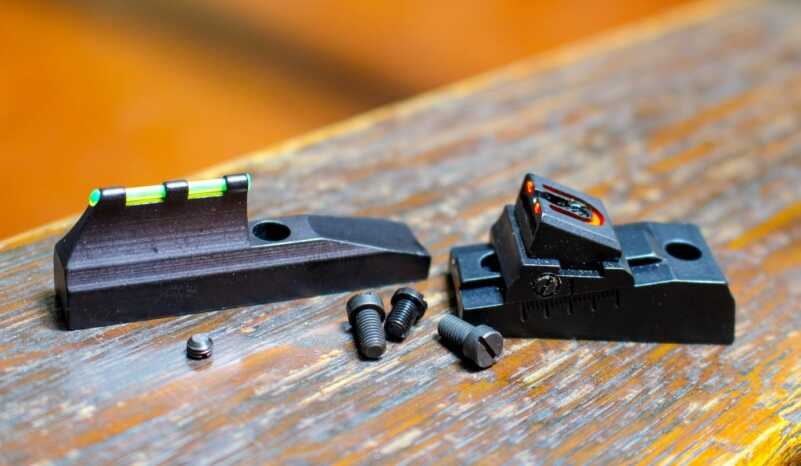
I decided to outfit the T/C with a Leupold riflescope, but fiber optic sights are provided with the rifle, should you choose that option, or if the law requires their use.
The entire operation is run by a match-grade trigger, with a smooth and easy feel to it. My Lyman digital trigger scale indicates that the Strike’s trigger breaks at an average of 2 pounds, 14 ounces, with little creep or over-travel. I like this trigger, especially for a muzzleloader, as there’s enough resistance to prevent the trigger from breaking too early with cold fingers or gloves, yet it’s light enough to place your shots accurately.
The polymer stock is strong, but light, perhaps a bit too light and that makes the Strike a wee bit barrel heavy. With a length of pull of 13 ½ inches, the Strike is a bit short for me, but I have long arms and tend to like my rifles longer. The Strike would work for most folks perfectly when wearing a hunting coat, for sure. That sling stud that affixes stock to barrel is located exactly where the knuckle of my left index wants to be, and that knuckle got a bit banged up while shooting the rifle, but again, that may be a result of wanting a bit more stock length. There is a nice, pliable recoil pad at the butt, and while the matte black polymer stock is rather smooth, there are two textured areas, one on the pistol grip, and the other on the top side of the forend. The edges of the stock, along with the ridge where the pistol grip meets the comb, are a bit sharper than I’d like, but overall it feels pretty good in the hands.
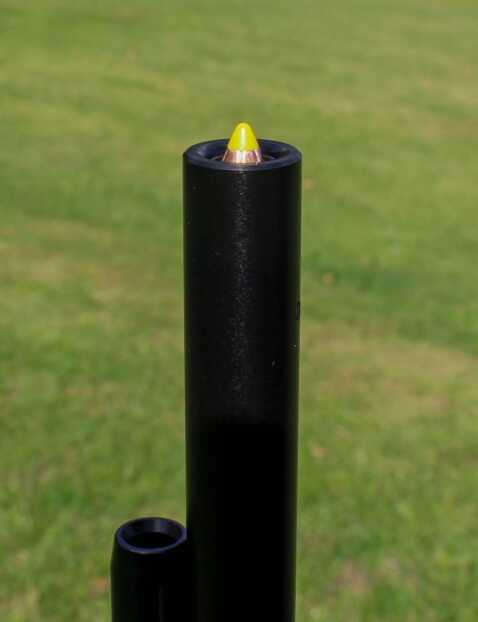
The T/C’s QLA false muzzle makes loading a pleasure; no ball starter needed.
The T/C Strike runs on a standard 209 shotgun primer. The rifle is only offered in .50 caliber, with a 1:28” twist rate, and the T/C QLA – or Quick Load Accurizor – barrel. This is a false muzzle, located about ¾ inches below the crown, where the actual rifling begins. This facilitates the easy loading of a saboted bullet, and will make a reload in a hunting situation much faster. The steel ramrod that is supplied with the rifle stores neatly within the forend, and is held there by a retainer spring, to prevent it from coming loose during recoil. I like that the T/C brass jag supplied with the rifle has a nice, deep cavity, perfect for loading spitzer and conical bullets.
I decided to equip the Strike with a scope – nothing too large – and settled upon the Leupold VX-R Hog riflescope – the one with the cool Pig-Plex reticle – in the 1-4×20 configuration. With a one-inch tube and plenty of eye relief, the Hog scope mounted nice and low to the bore, and allowed for fast target acquisition up close, and at 4X was enough magnification for longer shots. With finger-click adjustments of ¼ MOA, the scope is light, bright and rugged. The Pig Plex reticle uses a very bold crosshair on the horizontal and lower vertical lines, which transitions to a thin lone, culminating in a circle-dot. There are two hashes on the horizontal wire, perfect for establishing a lead on a running deer or hog, and two hashes on the lower vertical wire for trajectory adjustment. Those bold horizontal lines have the words PIG and PLEX on either side of center, in negative space, for a neat effect. All this adds up to a reticle that allows your eye to center naturally, making it perfect for late-season wary deer, or for a fleeing hog. Using Leupold detachable rings, it was a snap to mount the scope to the Weaver base on the Strike rifle, as there are four cross slots for mounting options. Considering the MSRP of $324.99 – with a street price of around $220 – this scope provides a considerable value, especially when trying to outfit your muzzleloader on a budget. Leupold’s Lifetime Warranty is an additional bonus. A couple of minutes with the bore-sighter got things close and it was off to the shooting range.
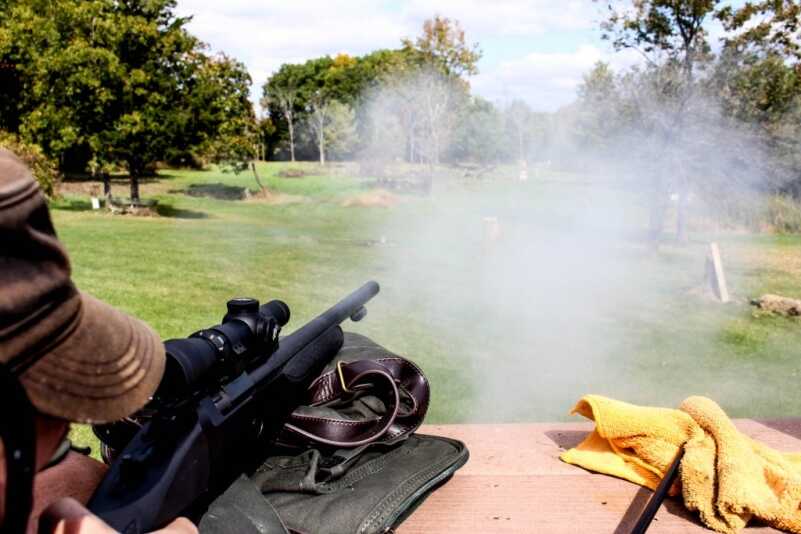
Even though Blackhorn 209 is not as dirty or smoky as blackpowder, a good cloud of smoke is still fun with a muzzleloader.
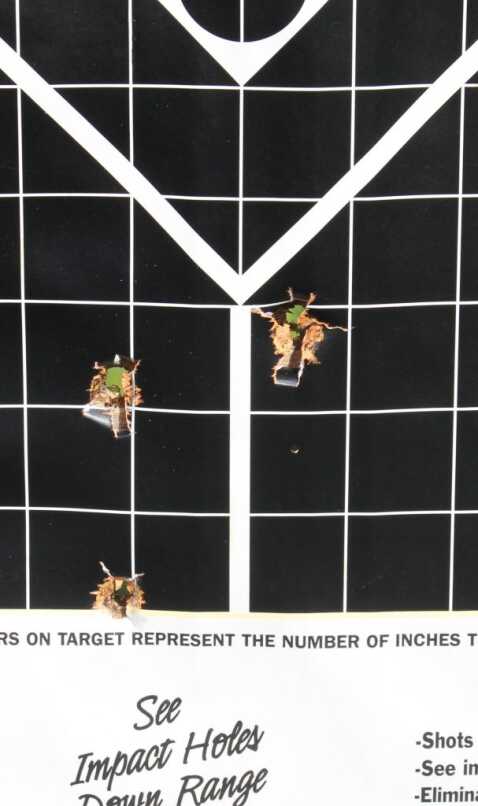
One of the three-shot groups from the T/C Strike; perfectly adequate for a hunting rifle.
Range Time
I tested a couple of different projectiles for the Strike: The Hornady XTP Mag .45 caliber 300-grain hollowpoint pistol bullets and the Thompson/Center Shockwave polymer tipped 250-grain muzzleloader bullets. Both bullets were used with a sabot. For Primers I used the Federal 209 shotgun primers, and for propellant, I chose both the Pyrodex Pellets from Hodgdon, and Blackhorn 209 black powder substitute.
The Hornady bullets did fine out to 50 yards, where group sizes were handing around 2 inches, but things began to open up considerably at 100 yards, so I’d regulate those for close quarter hunting. The T/C Shockwaves were a much better choice at the 100-yard mark, with three-shot groups hanging around 2 ½ inches, with a muzzle velocity of 1,875 fps. The Strike definitely likes to be clean; when trying a fourth or fifth shot without cleaning the bore, I could definitely feel the resistance when seating the bullet down the bore. The T/C T17 Natural Lube 1000 Plus made things easier, but three shots were about all I could get without sending a flyer. I highly suggest carrying the cleaning jag and brush in your possible bag at all times, when shooting saboted bullets. While accuracy wasn’t terrible with the Pyrodex Pellets, the rifle definitely preferred the Blackhorn 209, with the best groups coming with a load of 105 grains measured volumetrically on the Thompson/Center U-View powder measure. A few speedloaders with this amount of powder would make logical sense to anyone hunting with this rifle.
The QLA muzzle functioned as advertised; I didn’t need to use a ball starter at all. Simply place the saboted bullet in the smooth, false muzzle, and it stayed put, waiting patiently for the ramrod to send it home. Loading the Strike is easier and faster than other inline muzzleloaders I’ve used, for certain. Loading was made even easier with the T/C Rugged Range Rod, with a nice, wide polymer grip that saved your palm from being skewered by the end of the ramrod while at the range.
The Bottom Line
Is the T/C Strike the be-all-and-end-all of muzzleloading rifles? Well, with a winning lottery ticket you may find something that tickles your fancy a little more, but there are some valuable features wrapped up in this rifle for the $499 MSRP. One, as indicated above, it’s a well-thought-out design that worked perfectly. Two, the Armornite coating – leaving no exposed carbon steel to be beaten up by the chemical compounds that love to feast upon muzzleloaders – is an intrinsic value in and of itself. Three, I like the lack of an exposed hammer, and the slim, trim lines of the receiver, Four, it comes with T/C’s lifetime warranty, and that’s a value right there. Lastly, T/C rifles are proudly made in the U.S.A. and I’m the kind of guy that appreciates that. I do my best to use as many products made here in the U.S. – which is becoming a difficult prospect – and I like that T/C has kept their production in the country while still offering a great product. I think the T/C Strike is going to make hunters happy for many seasons to come.
For more information about the T/C Strike, click here.
For more information about Leupold scopes, click here.
For more information about Blackhorn 209, click here.
For more information about Hornady bullets, click here.
To purchase a T/C Strike on GunsAmerica, click here.

“I like that T/C has kept their production in the country”
They kinda don’t have a choice with that whole ITAR gross over-reach thing…